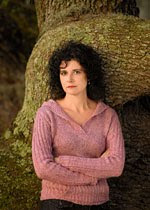(Wow. Still love that cover...)
When I finished Artifacts , I started talking about setting the next book in a new location, off Joyeuse Island. My editor wasn't so sure. She said that readers really liked Faye's ancestral home. I conceded that point, then asked, "Exactly how many dead bodies is she going to dig up on that little island?"
, I started talking about setting the next book in a new location, off Joyeuse Island. My editor wasn't so sure. She said that readers really liked Faye's ancestral home. I conceded that point, then asked, "Exactly how many dead bodies is she going to dig up on that little island?"
Also, I've never wanted to write the same book over and over, and I wanted to give my characters a chance to grow and change. In Artifacts , I put Faye through all manner of heck, but she was on her home turf. For the next two books, I took her out of her comfort zone. In Relics
, I put Faye through all manner of heck, but she was on her home turf. For the next two books, I took her out of her comfort zone. In Relics , particularly, I took her just a few hours' drive from her home, but to a place where it gets cold in the wintertime and the mountainous terrain is, frankly, a bit frightening to flatlander Faye. Dirt is an important thing to an archaeologist, and she had to deal with dirt that wasn't mostly beach sand. Most importantly, she's doing her first stint as a manager, she has a recalcitrant crew, and the people in the community don't want her there.
, particularly, I took her just a few hours' drive from her home, but to a place where it gets cold in the wintertime and the mountainous terrain is, frankly, a bit frightening to flatlander Faye. Dirt is an important thing to an archaeologist, and she had to deal with dirt that wasn't mostly beach sand. Most importantly, she's doing her first stint as a manager, she has a recalcitrant crew, and the people in the community don't want her there.
By the fourth book, I decided it was time to take Faye home, so Findings is set on Joyeuse. All the original characters (who survived) are back, and the old house is in mid-restoration. All is well...until she digs up a fabulous emerald in her back yard, and the last person she saw holding it, an old friend of hers, is found murdered. I will save the genesis of the emerald subplot for my upcoming series on how I get my titles. (There is just no end to the sausage-making possibilities that my career can provide.) But the historical subplot in Findings
is set on Joyeuse. All the original characters (who survived) are back, and the old house is in mid-restoration. All is well...until she digs up a fabulous emerald in her back yard, and the last person she saw holding it, an old friend of hers, is found murdered. I will save the genesis of the emerald subplot for my upcoming series on how I get my titles. (There is just no end to the sausage-making possibilities that my career can provide.) But the historical subplot in Findings is special to me.
is special to me.
I like to explore the nooks and crannies of history that others don't pay much attention to, so I turned my attention to the Confederate government. Many books have been written about the Civil War and its soldiers and the people who suffered at home, but not so much has been said about a social experiment that was doomed from the outset. I knew that a prominent man, Duncan Kenner, had urged Jefferson Davis (who I am reputedly related to, but that's beside the point) to free the slaves and remove the last excuse England had for not joining the war on the side of their southern trading partners. (Davis ignored him, obviously.) Kenner was part of a delegation that went to Europe to discuss these possibilities. I created a character, Jedediah Bachelder, who wasn't much of a diplomat, but who was chosen to be part of the delegation because he had, at the urging of his wife, already freed his own slaves.
Love letters between Jedediah and his wife Viola punctuate Faye's own story. And perhaps this part of making books is less like making sausage--I came to love Jedediah and Viola, and I came to understand that they made this book so much more than I'd intended. As I wrote the end to their story and to the book, I realized that my other books, like most mysteries, had been about justice. In fact, I call crime fiction "the literature of justice" in the way that many people call science fiction "the literature of ideas."
But Findings is not about justice. Or, rather, it's not only about justice. Findings
is not about justice. Or, rather, it's not only about justice. Findings is about love. There is no character in this book who is not touched, for good or ill, by romantic love. For that reason, I have a soft spot in my heart for this book.
is about love. There is no character in this book who is not touched, for good or ill, by romantic love. For that reason, I have a soft spot in my heart for this book.
Which is why I'm so glad that it has a cool cover. :-)
Mary Anna
















No comments:
Post a Comment